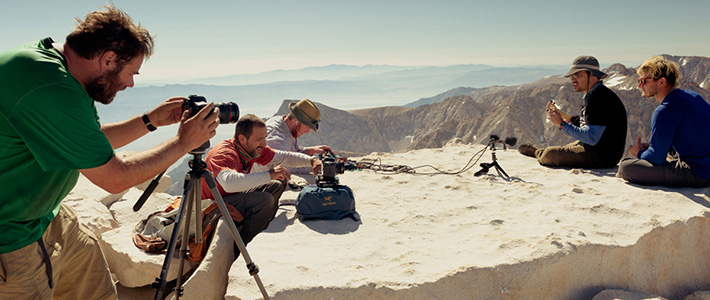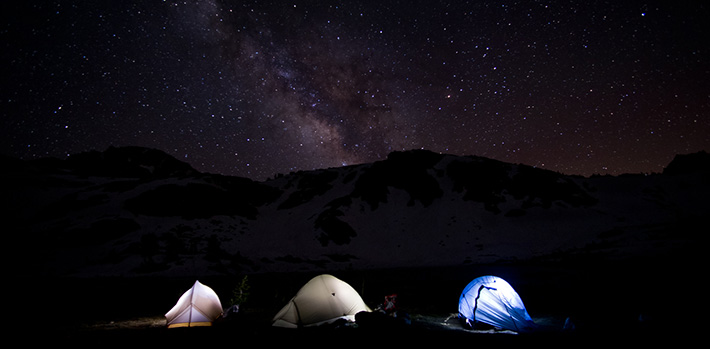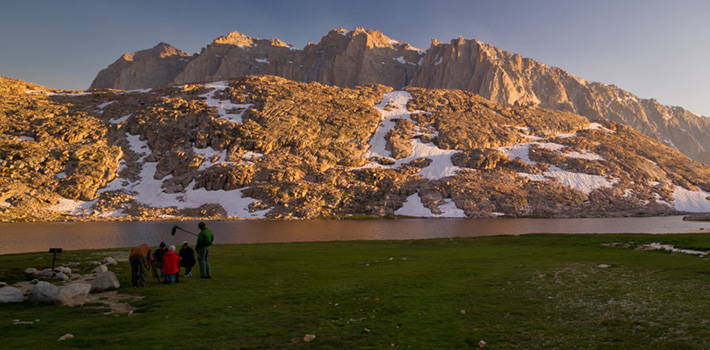The documentary "MILE... MILE & A HALF" has been featured before, with it's dazzling visuals and informative insight into creating art while on a long backpacking trip. This film took 2 years to produce, and it's finally complete! The creators have shared a clip just for the Fstoppers audience, and they have also answered some questions on the production of their film.
When we last checked in on the Muir Project, they were deep into post production, but had a couple of sparkling trailers to share from the footage they captured on their 230 mile, 25 day journey. If you're not familiar with the project, here is there first trailer:
Below is an exclusive clip from the finished film, provided solely for the fstoppers audience:
I corresponded with The Muir Project Prodcuers: Jen Serena, Ric Serena, Jason Fitzpatrick, and Durand Trench to find out how they managed weight, production gear, and planning for a project like this.
Weight is a major concern for multi-day backpacking. How did you decide what to take and what to leave at home in terms of video/photo gear?
JEN: For me, the hardest thing to leave behind was a flash or strobe of some kind. I'm used to working with a bunch of modifiers in my commercial/portrait work, and pulling back to body, lenses, filters, emergency blanket for bounce and headlamps for supplemental flash was an exciting challenge for me. Then again, I wouldn't consider myself a landscape photographer and that's what I was tasked with as well... so I guess that embarking on a new style of photography also made it easier for me to work with equipment constraints.
RIC: I was willing to lose a couple extra articles of clothing to make room for the Kessler Pocket Dolly. I was a little nervous heading up the first few passes because I wasn't sure if the weight was going to bog me down, but by the third pass I realized I would be fine. The biggest challenge for me is how many lenses to bring. Jen and I both shoot Nikons so we were able to bring three lenses to share (17mm, 24-70mm & 105mm Macro). I brought a 70-200 on a previous trip and realized it was probably overkill, but it sure would've been nice. I will say I wish she and I had brought two wide angle lenses. Because we weren't always together, I didn't have always have that lens on me when the moment was right.
JASON: Yeah, I think it would have to be lenses. I had a couple of primes that I sent home a week in, and later I regretted not having them. I was shooting with a 5D MII, and I had a novoflex adapter for Nikon lenses but it only worked on the primes so I was third in line for the 20mm prime.
DURAND: Picture is king, I know that as a sound guy, but my goal was for this trip was that people would be able to embrace a "full experience" meaning both sound and picture. Honestly, I did not even think about weight because when I think of most outdoor docs I think "bad sound" and my goal for this trip was to break that mantra. Every person chooses their own reason for going into the backcountry. I applaud all those who can do it ultra light, and I lose a few ounces each trip, but I want to bring back aural experiences for those who can't be out there...and for that reason the extra weight is what it is.

Did you come across any unique ideas for weight savings on your photo/video kits?
JEN: Headlamps for lightsource. Oh, and have your husband carry the heavier lens. (Being so short, I couldn't wear the 24-70 on my hip because it blocked raising my leg to high to climb over things on the trail. So I ended up carrying the wide and macro and he got the mid-range.)
RIC: Gorillapod for sure! So long as you have the heavy duty one that can handle the weight of a dslr and a good lens, it's a great way to get a stable shot and quick.
What piece of kit would you have was the most invaluable?
JEN: A Tokina 17mm/3.5 lens. Small enough to always be mounted and became my go-to look for the trip.
RIC: The Kessler Pocket Dolly definitely added an ENORMOUS amount of production value to the footage. It wasn't always the easiest thing to stop and set up quickly as it required taking off the pack, but completely worth the extra time. As much as I prefer primes, the Nikkor 24-70mm 2.8 was invaluable. It provided me the opportunity to get a descent focal range in a quick amount of time. So often, you're fighting with yourself to stop and grab a shot, because your body just wants you to stay in the rhythm of the hike. The 24-70 made that argument a little easier.
JASON: The Manfrotto carbon tripod, with a bogen 701 fluid head. It was reasonably light weight, and having the fluid head really made for nice pan and tilt shots. Even when I wasn’t moving the camera, having a good stable tripod was great. Ric also used it to great effect stabilizing the Kessler pocket dolly.

Did you plan certain shots before entering the field, or take each day and opportunity as it came?
JEN: It was definitely a "take each day as it comes" adventure for me. We've often remarked that we actually didn't know if we could physically complete the trail, let alone truly capture the experience, so I think shooting every day was much like trail life. You knew your miles you needed to put in and that there would be a camp at the end... but everything in between was a beautiful mystery. The few shots I did plan for: setting up for timelapses at different locations, a series of GoPro stills when walking through different terrain, and for some reason, that shot of our boots that we used for the poster was actually one I had thought of in advance. And yes, everyone thought I was crazy asking them to take off their boots on top of Mount Whitney, but everyone unlaced, held their breath and cooperated. Good thing... because it's been a visual that resonates with a lot of people.
RIC: No planning whatsoever. We stepped on the trail just hoping to capture the experience the best we could without really knowing where it would take us. That's one of the things I love about watching the film now: it gets better the further the film progresses because WE got better, both in our hiking rhythm and in our ability to seize the moment.
JASON: I certainly had ideas of types of shots I wanted to get, but nature can be fickle so I think most of what we ended up getting was in the moment. During the day while hiking we’d stop when a shot caught our eyes. In most of the camps we’d spend time every evening exploring the area and grabbing shots. Luckily the JMT isn’t too stingy with kodak moments.

How long did it take to edit? Was the story you wanted to present clear, or did it take many hours of trying to decide what would end up on the cutting room floor?
RIC: Jason provided a nice start for our editor with a paper cut he put together, and I organized the footage really well based on date and location so our editor didn't have to guess where we were on a given day (considering he wasn't with us), but editing a feature film is as much creative as it is technical, so it still required about 12 weeks of editing on the part of Edward Chin. The challenges were really how to make a story who's structure is clearly defined by a beginning and end of a thru hike remain interesting, and I think Ed did an incredible job doing it. We expected him to remove things we thought were funny, but we didn't expect him to keep moments we didn't think were funny. Inevitably, he was right. There are a lot of moments in the film that we would never have expected to get laughs but do every time.
JASON: We really lucked out with Ed Chin. Both Ric and I work as editors, but having somebody else cut it made it a much better film. We were very close to the material for obvious reasons, and couldn’t look at it objectively. Ed also isn’t a serious hiker like we are, so I think having somebody with a broader ascetic made the film more accessible than it would have been had Ric or I cut it.

If you did it again, what would you do differently?
JEN: We lost some gear along the way, and I definitely would've liked to have the head mount for the GoPro so people could see how gnarly some of those ascents/descents were. Scrambling up rock faces and down scree fully loaded definitely could've been recorded better. And yes, I'd get more night skies... we're always asked about that one.
RIC: This is always a hard question to answer because part of the charm of what we did (in my opinion) is that we didn't truly know what we were getting into (both on the trail and crafting the film after the fact). There are a lot of things I would do differently next time, but I don't know if that would necessarily make a BETTER film, maybe just a better technical film.
JASON: I would have shot more. That said no matter how much I shot, I think I would have wished I shot more. From a technical perspective, a lot of the shots of us around camp were shot with a consumer Canon Vixia camcorder. They came out nice, but they were 30i, and all of the other cameras were 24p. We got a hardware conversion so the finished product looks really good, but it was an annoyance during the post process. So from here on out, I’m making sure all of my camera are shooting at the same frame rate.
The completed film, is on iTunes for only $13 and other platforms.






Awesome work. Love the nat sound in the background. A few questions, How did you go about backing up footage along the way. Long term shoots are always tough, made harder if you arent able to back up as you go. Did you bring a larger number of cards, or a mobile backup device? As far as audio goes, was everything recorded with dedicated sound, or into the cameras?
I had never even heard of Kickstarter before stumbling across this project. So happy to be able to make my meager contribution to this beautiful film. I've watched the dvd 3 times already.